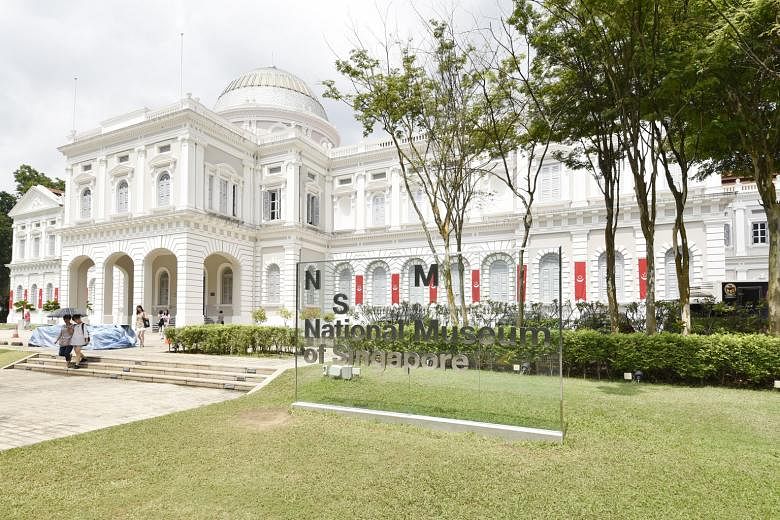It was 1942. Singapore was occupied by the Japanese after its British defenders surrendered.
Two men - one British and the other Japanese - risked their lives to cross enemy lines, all to protect a treasure trove of scientific information from the ravages of war.
That the National Museum of Singapore was left largely unscathed was due in part to the efforts of the British assistant director of the Botanic Gardens Eldred John Henry Corner and Japanese professor Hidezo Tanakadate.
Corner had a note from Straits Settlements' Governor Shenton Thomas, which pleaded with the Japanese to protect and safeguard the museum's collection.
He found an ally in Tanakadate, a volcanologist who was appointed to the museum when the Japanese invaded.
A scientist and researcher at heart, Tanakadate did what he could to protect the museum. He exaggerated his military ranking of sub-lieutenant to the Japanese soldiers and put up "do not enter" signs outside the museum, deterring troops from ransacking it.
Later, Tanakadate assumed directorship of the museum and appointed Marquis Yoshichika Tokugawa as president of the museum, which was called Syonan Museum and Library during the Occupation.
The marquis was a relative of the emperor and lent the institution protection and prestige in the eyes of the Japanese in Singapore.

The museum was not the only place of knowledge protected at the time. At the Singapore Botanic Gardens, Japanese researchers took steps to protect its scientific collections and enable its senior scientists, Eric Holttum and Corner, to continue their research.
When the British returned to Singapore, the favour was returned by Corner, who requested Lieutenant-Colonel Gilbert Archey, who was from the Monuments, Fine Arts and Archives division of the British Military Administration, to allow his Japanese colleagues to continue their research.
Assistant curator of the National Museum of Singapore Sharon Lim, 26, who researched the history of the museum extensively, commended the two men's bravery.

"The Japanese researchers came to the aid of their British counterparts because they looked beyond enemy lines and saw them as scientific colleagues in distress," she said.
The National Museum, which was gazetted as a national monument on Valentine's Day in 1992, marks its 130th anniversary at its Stamford Road location this year.
But its history actually dates back to a meeting in 1823, where Sir Stamford Raffles proposed founding a college in Singapore.
A Scottish missionary at the meeting, Robert Morrison, also suggested establishing a library and a museum.
However, it was only in 1849 that the museum started taking shape, with the donation of two ancient gold coins by Temenggong Ibrahim of Johor that jump-started the collection.
At the time, the museum was just a wing inside a library in Singapore Institution - now Raffles Institution.
When the second governor of the Straits Settlements Andrew Clarke arrived in Singapore, discussions for a separate building for the museum gained momentum.
In 1884, the construction of the newly renamed Raffles Library and Museum commenced at Stamford Road and was completed in 1887.
The museum then consisted only of the prominent dome and the two wings on either side of it that make up the front of the building.
Designed by colonial engineer Henry E. McCallum, it is largely neo-Palladian in style. The dome has 50 pieces of stained glass, each about 2.75m long. The glass panels and arched windows ensure that the interior of the building is naturally illuminated.
Prior to the 1960s, the museum focused more on its zoological and ethnological collection but, when Singapore became independent, it moved towards historical and cultural themes.
-
THROUGH THE YEARS
-
1823
Sir Stamford Raffles proposed founding a college in Singapore. Scottish missionary Robert Morrison suggested establishing a library and a museum.
1849
The museum started taking shape with the donation of two ancient gold coins by Temenggong Ibrahim of Johor that jump-started the collection. Then, the museum was just a wing inside a library in what is now Raffles Institution.
1884
Construction of the newly renamed Raffles Library and Museum commenced at Stamford Road and was completed in 1887.
1942
Start of the Japanese Occupation. British assistant director of the Botanic Gardens Eldred John Henry Corner and Japanese professor Hidezo Tanakadate worked together to protect the museum's treasure trove.
1960
Raffles Museum renamed as the National Museum.
1992
The National Museum was gazetted as a national monument.
1993
The museum was renamed the Singapore History Museum.
2006
The museum was renamed again as the National Museum of Singapore.
2017
The National Museum of Singapore marks its 130th anniversary at its Stamford Road location.
in 2006 as the National Museum of Singapore.
Today, the museum follows in the spirit of the researchers who safeguarded it during wartime.
Director of the National Museum of Singapore Angelita Teo, 45, said she hopes the museum is less about its exhibitions and acts more as a medium to start conversations.
She cited The World Press Photo exhibition, which was held at the museum in March, as a way to get people thinking about difficult social issues. The event showcases prize-winning photographs that capture the most powerful, poignant and sometimes provocative news images from around the world, including pictures of war and tragedy.
Ms Teo added that this exhibition, especially, tends to start very important conversations, like the relevance of terrorism to Singapore.
She said: "In the 1940s, the British and Japanese researchers put their differences aside because they realised the importance of knowledge and were thinking of what they could do to further humanity. This demonstrates the importance of the work that museums undertake even today; a role that transcends conflict and shapes common purpose."
- The National Museum of Singapore will have a World War II exhibition called Witness To War: Remembering 1942 from September. Admission to the museum and this exhibition is free for citizens, permanent residents, children aged six and below, as well as first caregivers of persons with disabilities.

